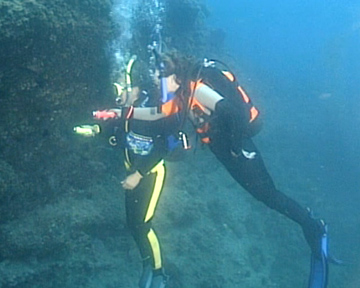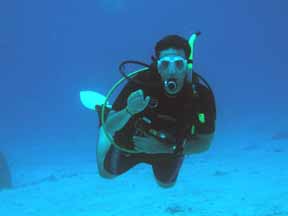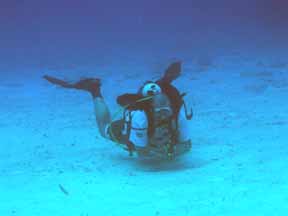
|
|
|
|
|
|
|
 |
|
 |
|
|
|
|
Our site is 256 bit SSL SECURED. SSL (Secure Socket Layer) is the industry standard for viewing and sending sensitive information
on an internet browser. Click on the SSL image below see our site report.
|

|
|
|
 |
|
 |
|
|

|
 |
|
 |
|
|
|
|
As of January 1, 2017, DIVING FOR FUN will
NO LONGER be offering training services. However, we wanted to continue to provide
a list of the classes we offered along with course outlines as a reference for all our past customers.
 Course Overview:
If you want to fine-tune your buoyancy and soar over reefs, extend bottom time by reducing
air consumption and prolong the life of your dive equipment, the Peak Performance Buoyancy
Specialty course is for you. Course Overview:
If you want to fine-tune your buoyancy and soar over reefs, extend bottom time by reducing
air consumption and prolong the life of your dive equipment, the Peak Performance Buoyancy
Specialty course is for you.
Prerequisites:
Must be at least 10 years old and certified as a Junior Open Water Diver or an Open Water Diver.
 Course Activities:
You will learn how to use the Basic Weighting Guidelines to determine the correct amount of
weight. Then you will practice the fundamentals of peak performance buoyancy during two open
water dives under instructor supervision, including the buoyancy check at the surface, fine-tuning
buoyancy underwater, weight positioning for trim, streamlining and visualization. Course Activities:
You will learn how to use the Basic Weighting Guidelines to determine the correct amount of
weight. Then you will practice the fundamentals of peak performance buoyancy during two open
water dives under instructor supervision, including the buoyancy check at the surface, fine-tuning
buoyancy underwater, weight positioning for trim, streamlining and visualization.
- Classroom:
There is one classroom session. The classroom session
will cover the Peak Performance Buoyancy in the Adventures in Diving Manual, review your knowledge
review answers and prepare you for both of the open water dives.
- Independent Study:
Read the chapter Peak Performance Buoyancy in the
Adventures in Diving Manual and complete the knowledge review located at the end of the chapter.
Watch the entire Peak Performance Buoyancy DVD. You will need to turn in the knowledge review prior to certification or provide a copy of an Adventure
Log signed by an appropriate instructor if you have already done dive one in connection with your
Adventure Diver or Advanced Open Water Diver Certification.
- Open Water Dives:
The 2 open water dives are done at an area lake/scuba park
or on a dive trip.
 Forms Required:
Students training will need to complete the three (3) forms: Liability Release, Statement of Understanding, and
Medical Statement prior to entering the water. Forms Required:
Students training will need to complete the three (3) forms: Liability Release, Statement of Understanding, and
Medical Statement prior to entering the water.
Materials/Equipment Required: The Adventures in Diving Manual.
Recommended: The Peak Performance Buoyancy DVD.
Length of Course:
If you have read the Peak Performance Buoyancy chapter in The Adventures in Diving Manual, completed
the knowledge review and watched the entire video prior to coming to class, the classroom session
should take approximately 1 hour depending upon class size.
 Related Specialties:
Project AWARE,
Boat Diver,
Coral Reef Conservation,
Deep Diver,
Drift Diver,
Dry Suit Diver,
Enriched Air (Nitrox),
Equipment Specialist,
Fish ID,
Multi-Level Diver,
Night Diver,
Peak Performance Buoyancy,
UW Naturalist,
UW Navigation,
UW Digital Photo,
UW Photo,
UW Search & Recovery,
Wreck Diver. Related Specialties:
Project AWARE,
Boat Diver,
Coral Reef Conservation,
Deep Diver,
Drift Diver,
Dry Suit Diver,
Enriched Air (Nitrox),
Equipment Specialist,
Fish ID,
Multi-Level Diver,
Night Diver,
Peak Performance Buoyancy,
UW Naturalist,
UW Navigation,
UW Digital Photo,
UW Photo,
UW Search & Recovery,
Wreck Diver.
|
Dive 1:
- Assembly of weight system and use of the "Basic Weighting Guidelines".
- Visualization practice.
- Getting in the water, buoyancy check and descent.
- Hovering - If appropriate, establish neutral buoyancy using the fin pivot, then
hover for one minute without fin movement or hand movement. During the hover practice breath control to make
minor depth adjustments.
- Buoyancy Game Add-on.
- Ascent - Ascend at a rate not to exceed 60 feet per minute. Vent air as needed
from your BCD to maintain neutral buoyancy. Perform a safety stop at 15 feet for 3 minutes. Maintain neutral
buoyancy at the safety stop.
- Post-dive procedures - Signal support personnel once on the surface after a dive
(if appropriate) and conduct a post-dive buoyancy check. Achieve comfortable positive buoyancy using your BCD.
- Debriefing - Discuss differences between buoyancy checks at the beginning and end
of the dive.
Dive 2:
- Visualization practice.
- Prepare personal diving equipment. Rig weight system, estimating amount of weight
using the Basic Weighting Guidelines. Position and distribute the weight for comfort and desired body position
(trim) in the water.
- Visualization practice. Just before suiting up, take time to visualize yourself
attaining Peak Performance Buoyancy while diving.
- Conduct a pre-dive buoyancy check.
- During the dive: Demonstrate efficient fin kicks, using long, slow strokes and
gliding after each kick. Avoid all contact with the bottom - body and equipment. Practice hovering over the
bottom without kicking or hand movement. While hovering, practice making minor depth adjustments using breath
control only. Maneuver close to a nonliving portion of the bottom (rock, sand, etc.) without touching it and
then back away using neutral buoyancy with hand or fin sculling.
- Ascent: Ascend at a rate not to exceed 60 feet per minute. Vent air as needed from
your BCD to maintain neutral buoyancy. Perform a safety stop at 15 feet for 3 minutes. Maintain neutral buoyancy
at the safety stop.
- Post-dive procedures: Signal support personnel once on the surface after a dive
(if appropriate) and conduct a post-dive buoyancy check. Achieve comfortable positive buoyancy using your BCD.
- Debriefing - Discuss differences between buoyancy checks at the beginning and end
of the dive.
|
 |
If you need additional information or have questions,
we can be reached at our Contact Us page or visit our
Sign Up page.
|
 |
|
|
|
|
|
 |
|
 |
|

|